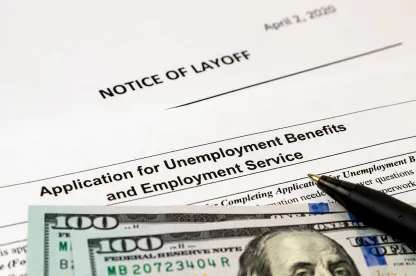The U.S. Department of Labor (DOL) published guidance about the notice requirements of the federal Worker Adjustment and Retraining Notification (WARN) Act during the COVID-19 pandemic. The guidance takes the form of frequently asked questions posed by employers, employees and state agencies.
Guidance for employers includes the following topics:
-
Required Notice. The WARN Act requires employers with 100 or more full-time employees (not counting workers who have fewer than six months on the job) to provide at least 60 calendar days of advance written notice of a worksite closing affecting 50 or more employees, or a mass layoff affecting at least 50 employees and one third of the worksite’s total workforce, or 500 or more employees at the single site of employment during any 90-day period. Notably, in certain situations where layoffs or worksite closings occur due to faltering companies, unforeseen circumstances or natural disasters, 60 days’ advance notice is not required. Instead, employers are to provide as much notice to their employees as possible.
-
Furloughs and Temporary Layoffs. Notice to employees is required for furloughs and temporary layoffs that last longer than six months. A furlough or temporary layoff without notice that was originally believed to be brief but later is extended beyond six months, may violate the act unless:
-
The extension is due to business circumstances not reasonably foreseeable at the time of the initial layoff and
-
Notice is provided when it becomes reasonably foreseeable that the extension is required.
-
-
Exceptions for Permanent Layoffs Caused by COVID-19. The DOL directs employers to the “unforeseeable business circumstances” exception to the Act, 20 C.F.R. § 639.9, to determine whether the employer may claim an exception to the WARN Act because of COVID-19. This exception applies to plant closings and mass layoffs caused by business circumstances that were not reasonably foreseeable at the time the 60-day notice would have been required. Applicability of the exception is determined on a case-by-case basis and is dependent on the employer’s commercially reasonable business judgment and particular business circumstances. Even if the exception applies, employers are not relieved of their duty to provide notice to employees.
Employers are still required to:
-
Give as much notice as practicable and
-
Include a brief statement of the reason for giving less than 60 days’ notice along with the other required elements of a WARN notice.
-
-
Email Notification. Employers may issue WARN notices to employees, State Rapid Response Coordinators and Chief Elected Officials of the unit of local government via email so long as the content of the notice complies with 20 C.F.R. § 639.7. The DOL recommends employers check with state agencies to determine their preferred method of delivery.
The DOL noted the limitations of its role with regard to the WARN Act, i.e., to provide guidance and information pertaining to the Act. In light of this limitation, the DOL does not provide advisory opinions on specific cases or issue letters of compliance to employers. The DOL also does not maintain a database of WARN notices or require employers to provide notices to the Department.
Employers also may be subject to state and local notification requirements. Employers are not exempt from fulfilling applicable local laws merely by complying with the federal WARN Act. Consequently, employers contemplating closings and temporary or permanent layoffs should consult legal counsel regarding their specific circumstances.



 />i
/>i

